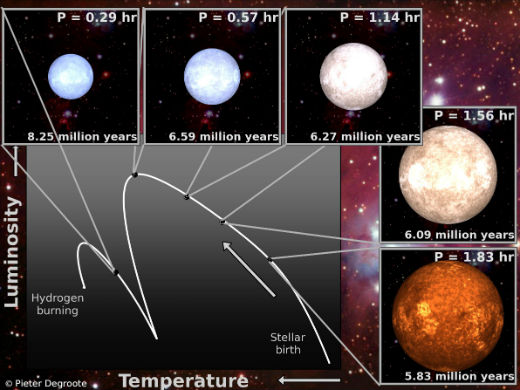A young star's age can be gleamed from nothing but sound waves

In a young region like the so-called Christmas Tree Cluster, stars are still in the process of forming. A star is 'born' once it becomes optically visible (bottom right). During its further evolution, the star contracts and gets smaller in size and hotter until the core temperature is sufficient to start nuclear burning of hydrogen. This marks the end of the stellar childhood phase (bottom left). While the young star evolves from its birth to the beginning of hydrogen burning, its pulsation properties change: the least evolved, i.e., youngest, stars pulsate slower and the most evolved while the oldest stars pulsate faster. Credit: ESO
Determining the age of stars has long been a challenge for astronomers. In experiments published in the journal Science, researchers at KU Leuven's Institute for Astronomy show that 'infant' stars can be distinguished from 'adolescent' stars by measuring the acoustic waves they emit.
Stars are often born in clusters, the result of contracting molecular clouds of gas and dust particles. As a star evolves from infant to adolescent, gravitational pull causes it to contract. It gets smaller in size and hotter until the core temperature is sufficient to start nuclear burning of hydrogen. At this point, the star stabilizes and becomes an 'adult'. It stays this way for vast tracts of time.
Determining the age of a young star is far from simple, and knowing which molecular cloud a star comes from gives only a vague idea of its age. But researchers have come up with a way to determine the age of stars by measuring their acoustic vibrations using ultrasound technology similar to that used in the field of medicine.
Acoustic vibrations – sound waves – are produced by radiation pressure inside stars. First author Konstanze Zwintz, a postdoctoral researcher at KU Leuven's Institute for Astronomy, and her colleagues studied the vibrations of 34 stars aged under 10 million years and sized between one and four times the mass of our sun.
“Our data shows that the youngest stars vibrate slower while the stars nearer to adulthood vibrate faster. A star's mass has a major impact on its development: stars with a smaller mass evolve slower. Heavy stars grow faster and age more quickly,” says Dr. Zwintz.
While theoretical physicists have posited before that young stars vibrate differently than older stars, Zwintz' study is the first to confirm these predications using concrete data from outer space.
“We now have a model that more precisely measures the age of young stars,” says Zwintz. “And we are now also able to subdivide young stars according to their various life phases.”
The researchers studied the nebula known commonly as the Christmas Tree Cluster. Their data was obtained from the Canadian MOST satellite and the European CoRoT satellite as well as from ground-based facilities such as the European Southern Observatory (ESO) in Chile.
Media Contact
All latest news from the category: Physics and Astronomy
This area deals with the fundamental laws and building blocks of nature and how they interact, the properties and the behavior of matter, and research into space and time and their structures.
innovations-report provides in-depth reports and articles on subjects such as astrophysics, laser technologies, nuclear, quantum, particle and solid-state physics, nanotechnologies, planetary research and findings (Mars, Venus) and developments related to the Hubble Telescope.
Newest articles

Security vulnerability in browser interface
… allows computer access via graphics card. Researchers at Graz University of Technology were successful with three different side-channel attacks on graphics cards via the WebGPU browser interface. The attacks…

A closer look at mechanochemistry
Ferdi Schüth and his team at the Max Planck Institut für Kohlenforschung in Mülheim/Germany have been studying the phenomena of mechanochemistry for several years. But what actually happens at the…

Severe Vulnerabilities Discovered in Software to Protect Internet Routing
A research team from the National Research Center for Applied Cybersecurity ATHENE led by Prof. Dr. Haya Schulmann has uncovered 18 vulnerabilities in crucial software components of Resource Public Key…





















